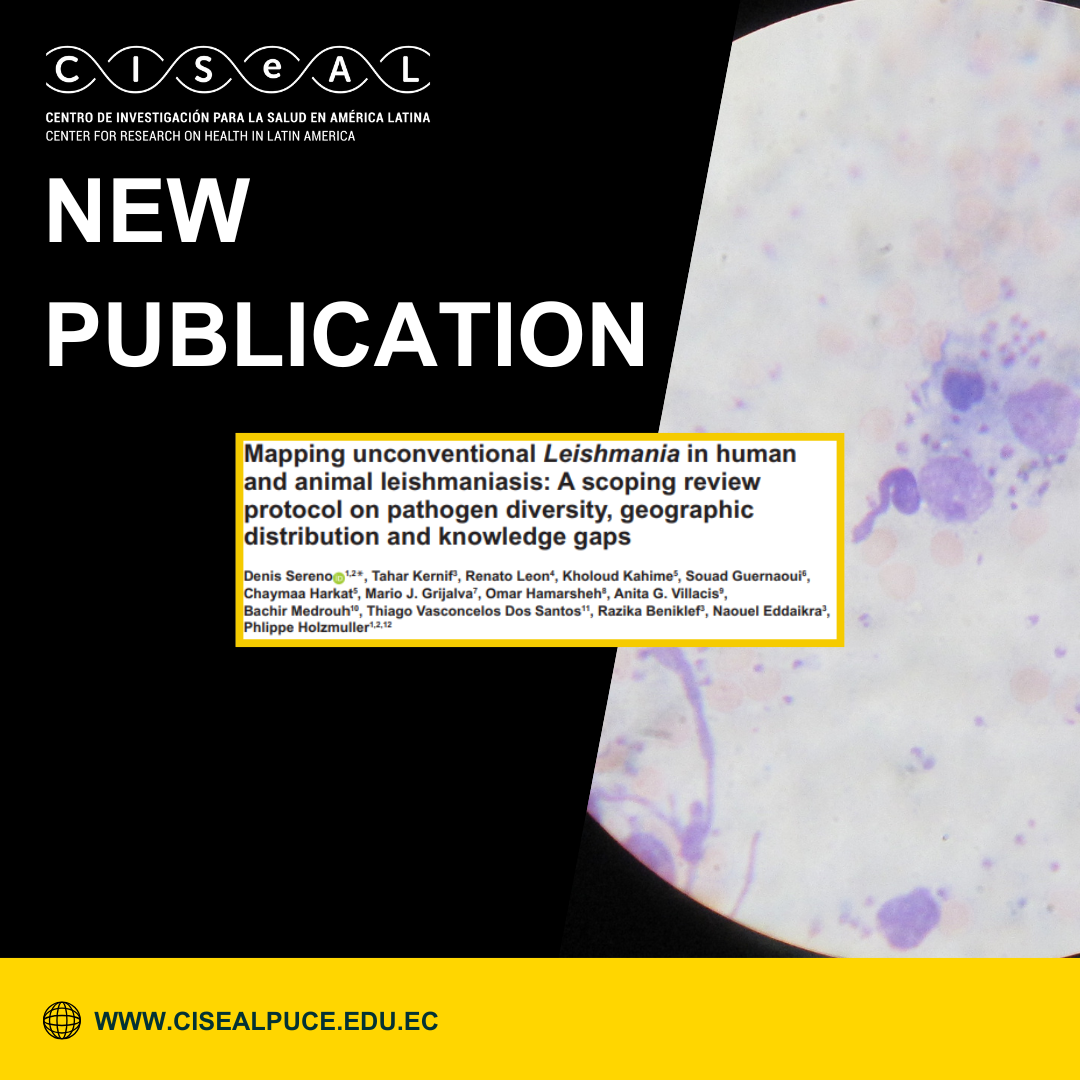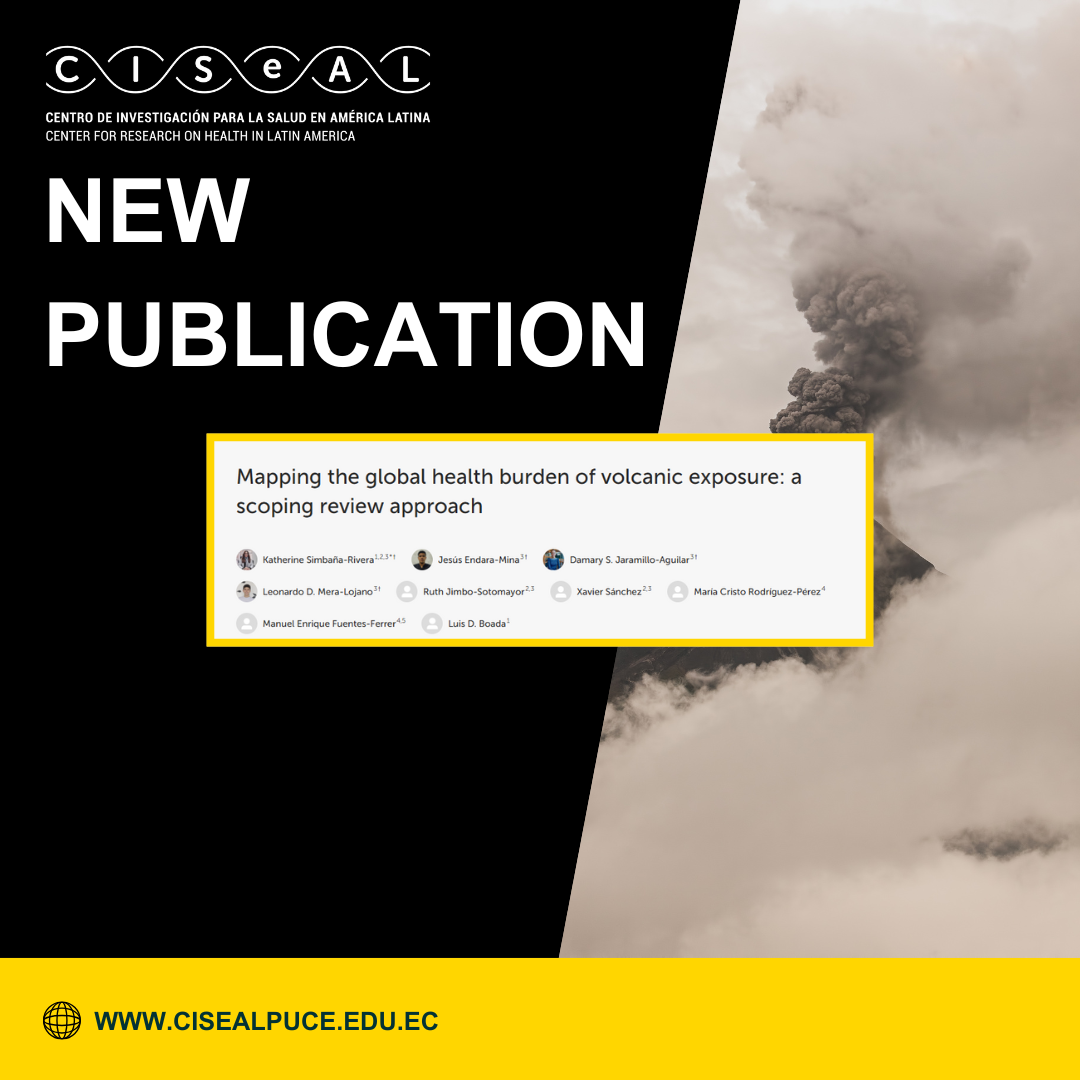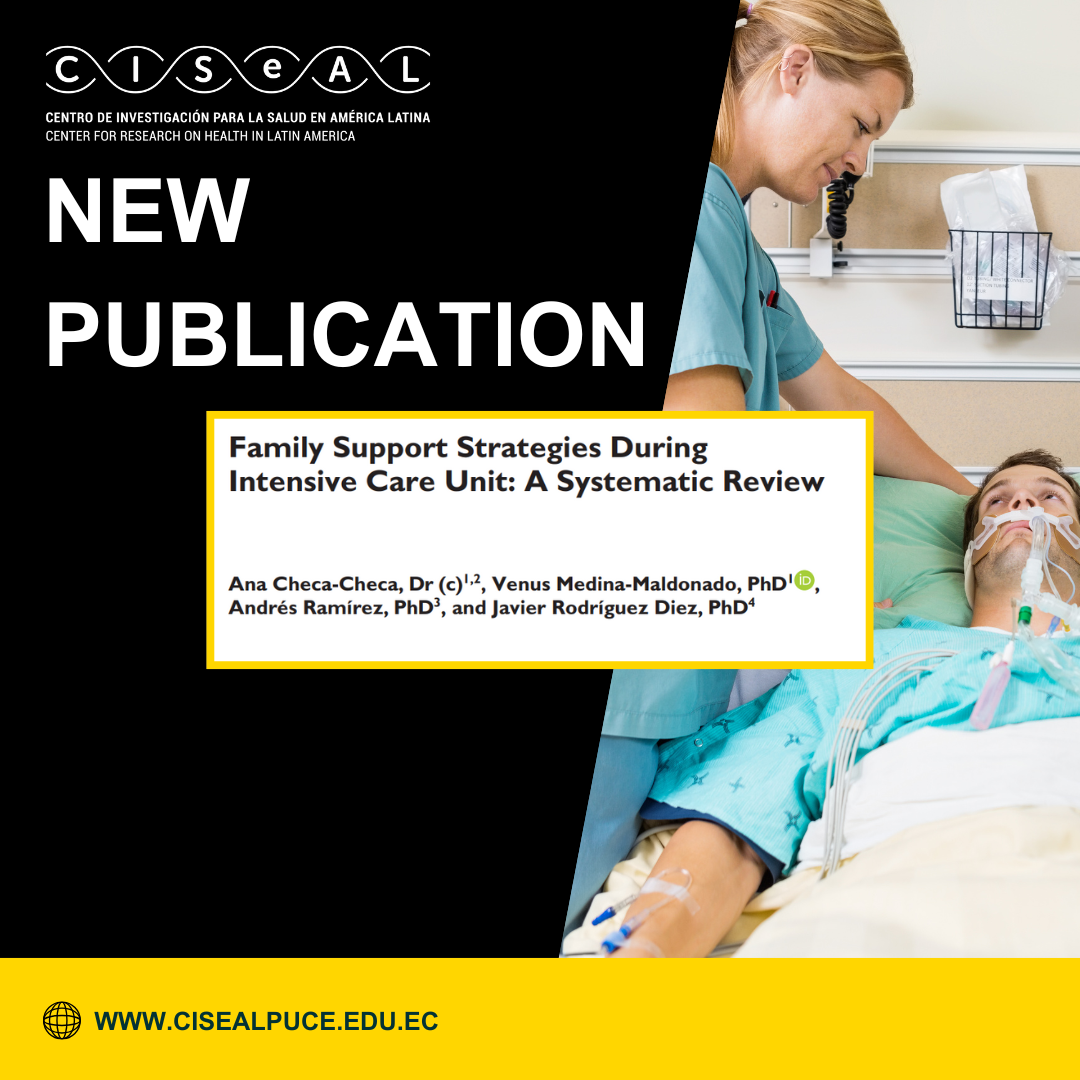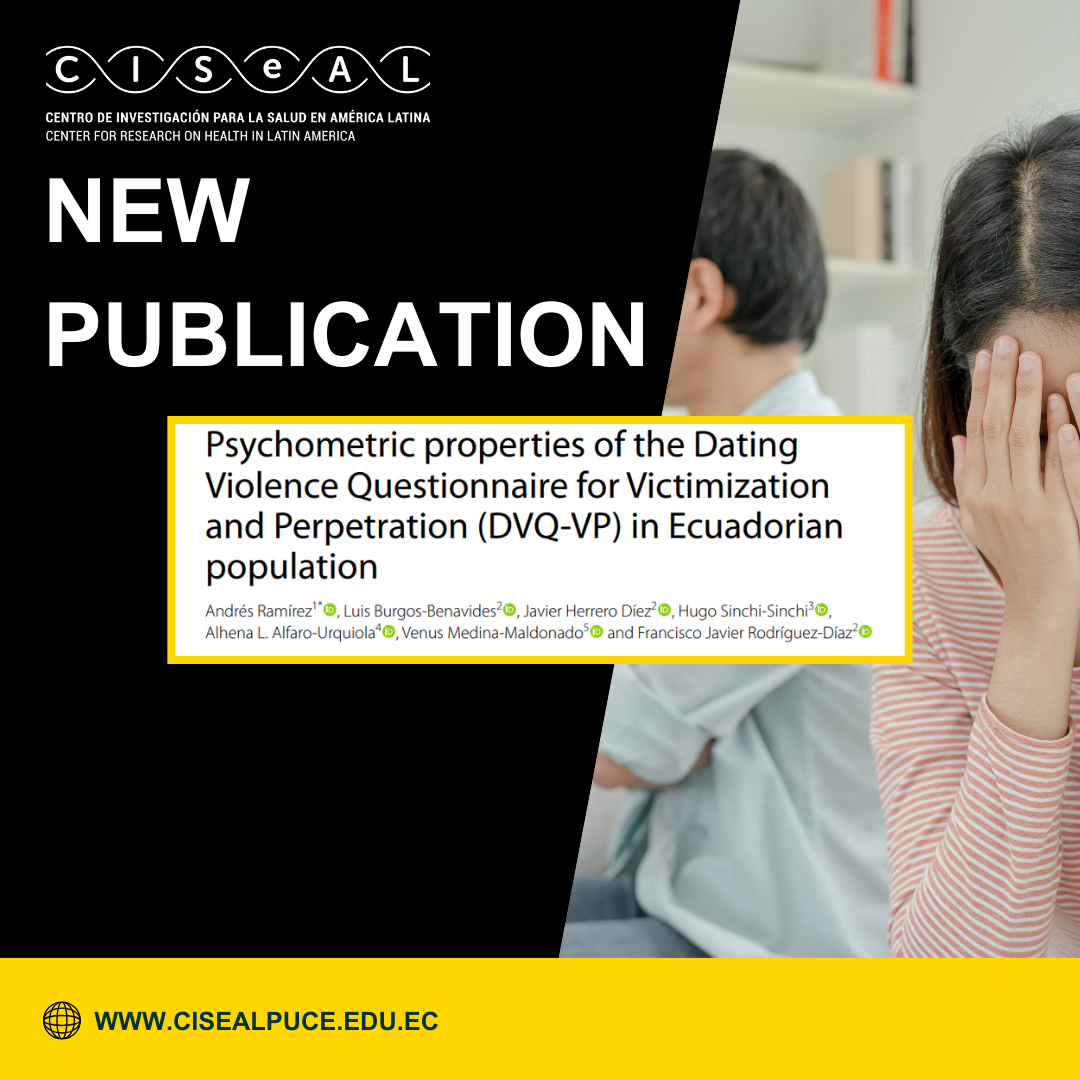 The research led by Dr. Denis Sereno, researcher at the IRD (Institut de Recherche pour le Développement), in collaboration with Dr. Mario Grijalva and Dr. Anita Villacís, principal investigators at CISeAL, addresses an emerging challenge in global public health: the diversity and behavior of non-conventional Leishmania species that cause infections in both humans and animals.
The research led by Dr. Denis Sereno, researcher at the IRD (Institut de Recherche pour le Développement), in collaboration with Dr. Mario Grijalva and Dr. Anita Villacís, principal investigators at CISeAL, addresses an emerging challenge in global public health: the diversity and behavior of non-conventional Leishmania species that cause infections in both humans and animals.
Traditionally, leishmaniases have been attributed to a limited group of species (such as L. donovani, L. infantum, L. major, or L. tropica), each associated with a well-defined clinical presentation. However, advances in molecular diagnostics have revealed a more complex scenario. Recent cases have identified atypical or emerging species, such as those belonging to the subgenus Mundinia (L. martiniquensis, L. orientalis), as well as unusual clinical manifestations in classical species—challenging traditional models of diagnosis and surveillance.
 After the COVID-19 pandemic, the city of Quito faced the enormous challenge of transforming its primary health care system, which had been weakened by the health emergency and hospital overload. The following study analyzes how the city reconfigured its model of Community Primary Health Care (CPHC) during and after the pandemic, becoming a regional reference in health resilience and local governance. Entitled “Strengthening primary health care resilience through community innovation: a qualitative case study from Quito’s response to COVID-19”, it was led by Dr. Betzabé Tello, principal researcher at CISeAL-PUCE, and received support from the World Bank as part of its technical assistance agenda to strengthen resilient primary health care systems in Latin America.
After the COVID-19 pandemic, the city of Quito faced the enormous challenge of transforming its primary health care system, which had been weakened by the health emergency and hospital overload. The following study analyzes how the city reconfigured its model of Community Primary Health Care (CPHC) during and after the pandemic, becoming a regional reference in health resilience and local governance. Entitled “Strengthening primary health care resilience through community innovation: a qualitative case study from Quito’s response to COVID-19”, it was led by Dr. Betzabé Tello, principal researcher at CISeAL-PUCE, and received support from the World Bank as part of its technical assistance agenda to strengthen resilient primary health care systems in Latin America.
The study aimed to document how Quito transitioned from a reactive, hospital-centered model to a community-based, preventive, and territorial one, grounded in the social determinants of health and citizen participation. To achieve this, a qualitative approach was applied, including a documentary review of institutional sources, municipal reports, legal frameworks, and accountability documents from 2014 to 2024, complemented by in-depth interviews with health professionals, decision-makers, and administrative staff. This approach allowed for an understanding of both the institutional structure and the implementation processes of the model throughout the Metropolitan District.

CISeAL researchers Carolina Portero, M.Sc., in collaboration with Dr. María Raquel Marchán-Rivadeneira, have developed a study that proposes an innovative strategy to combat SARS-CoV-2 infections through the development of synthetic probiotic bacteria capable of producing and releasing neutralizing nanoantibodies directly at the site of infection. The work is based on the premise that, although vaccines have been fundamental in controlling the pandemic, there is still a need for antiviral therapies that block early stages of the viral cycle, such as the binding of the RBD domain of the spike protein to the human ACE2 receptor, a key process for the virus to enter cells. In this context, nanoantibodies, derived from camelid antibodies, offer advantages over monoclonal antibodies due to their small size, stability, and ease of genetic manipulation, but they face limitations associated with their rapid degradation and the need for repeated administration. To overcome these challenges, a recombinant strain of Lactococcus lactis, a safe and widely used probiotic, was designed to act as a biological vehicle for producing and carrying nanoantibodies. Through genetic engineering, vectors capable of expressing the H11-D4 and H11-H4 nanoantibodies anchored to the bacterial surface were constructed, optimizing the secretion and fixation system to ensure their stability and external exposure.
 The study conducted by Dr. Katherine Simbaña, Dr. Xavier Sánchez, and Dr. Ruth Jimbo Sotomayor, professors at the School of Medicine of PUCE and researchers at CISeAL, together with other experts, provides a global overview of the health effects of exposure to volcanic activity through a scoping review approach. The research is framed within a context where there are approximately 1,500 potentially active volcanoes worldwide, more than 550 of which have erupted in the past century, with a marked concentration in the Pacific Ring of Fire that runs through densely populated areas of Asia and the Americas. Volcanoes such as Fuego in Guatemala, Popocatépetl in Mexico, Tungurahua in Ecuador, and Merapi in Indonesia have produced highly explosive eruptions with major social and health consequences. The so-called “volcanic products,” which include ash, gases, pyroclastic flows, lava, and chronic emissions of pollutants such as carbon dioxide or radon, have differentiated health impacts depending on their physical and chemical properties, as well as on the duration and magnitude of exposure. In addition, external factors such as climate change, which intensifies secondary phenomena such as lahars or ash resuspension, and social determinants such as poverty, unplanned urbanization, and limited land-use planning significantly increase the vulnerability of populations living in high-risk areas.
The study conducted by Dr. Katherine Simbaña, Dr. Xavier Sánchez, and Dr. Ruth Jimbo Sotomayor, professors at the School of Medicine of PUCE and researchers at CISeAL, together with other experts, provides a global overview of the health effects of exposure to volcanic activity through a scoping review approach. The research is framed within a context where there are approximately 1,500 potentially active volcanoes worldwide, more than 550 of which have erupted in the past century, with a marked concentration in the Pacific Ring of Fire that runs through densely populated areas of Asia and the Americas. Volcanoes such as Fuego in Guatemala, Popocatépetl in Mexico, Tungurahua in Ecuador, and Merapi in Indonesia have produced highly explosive eruptions with major social and health consequences. The so-called “volcanic products,” which include ash, gases, pyroclastic flows, lava, and chronic emissions of pollutants such as carbon dioxide or radon, have differentiated health impacts depending on their physical and chemical properties, as well as on the duration and magnitude of exposure. In addition, external factors such as climate change, which intensifies secondary phenomena such as lahars or ash resuspension, and social determinants such as poverty, unplanned urbanization, and limited land-use planning significantly increase the vulnerability of populations living in high-risk areas.
The study, conducted using the scoping review methodology and following international guidelines such as PRISMA-ScR, included 83 articles after a rigorous selection process that began with 2,077 records identified in databases such as PubMed, Scopus, and Web of Science. The countries with the largest number of publications were the United States, Japan, and Iceland, and among the most studied volcanoes are Mount St. Helens, Kīlauea, Eyjafjallajökull, and Miyakejima. Most of the analyzed studies focused on adult populations, while research on children was less frequent. The most studied pollutants were toxic gases and volcanic ash, both responsible for a wide range of health effects.
 This study, with the participation of CISeAL researcher Venus Medina, systematically analyzes support strategies for families of critically ill patients admitted to intensive care units (ICUs), focusing on the effectiveness of nursing interventions compared to standard care. The review covered articles published between 2015 and 2025 in databases such as PubMed, Scopus, CINAHL, SciELO, and Web of Science, following the PRISMA 2020 guidelines, and applied quality assessment tools such as the Johns Hopkins model and the ROB 2 instrument. Eighteen studies with diverse samples, although predominantly female, were included. These studies evaluated interventions aimed at communication, decision-making, and strengthening the emotional bond between family members and ICU patients. Strategies ranged from in-person programs—such as structured communication during rounds, open visitation policies, and family participation in care—to technology-mediated approaches that facilitated guidance and decision-making.
This study, with the participation of CISeAL researcher Venus Medina, systematically analyzes support strategies for families of critically ill patients admitted to intensive care units (ICUs), focusing on the effectiveness of nursing interventions compared to standard care. The review covered articles published between 2015 and 2025 in databases such as PubMed, Scopus, CINAHL, SciELO, and Web of Science, following the PRISMA 2020 guidelines, and applied quality assessment tools such as the Johns Hopkins model and the ROB 2 instrument. Eighteen studies with diverse samples, although predominantly female, were included. These studies evaluated interventions aimed at communication, decision-making, and strengthening the emotional bond between family members and ICU patients. Strategies ranged from in-person programs—such as structured communication during rounds, open visitation policies, and family participation in care—to technology-mediated approaches that facilitated guidance and decision-making.
 This study, with the participation of Dr. Venus Medina, principal investigator at CISeAL, addresses dating violence as an early manifestation of intimate partner violence, with significant consequences for health and social well-being. This phenomenon, characterized by its complexity, variability, and bidirectionality, requires methodologically rigorous instruments that allow for the precise identification of its dynamics among adolescents and young adults. The DVQ-VP, short for Dating Violence Questionnaire for Victimization and Perpetration, emerges as a culturally adapted and validated tool in Spanish-speaking populations, which assesses both victimization and perpetration across five dimensions: physical violence, psychological violence, sexual violence, controlling behaviors, and relational aggression.
This study, with the participation of Dr. Venus Medina, principal investigator at CISeAL, addresses dating violence as an early manifestation of intimate partner violence, with significant consequences for health and social well-being. This phenomenon, characterized by its complexity, variability, and bidirectionality, requires methodologically rigorous instruments that allow for the precise identification of its dynamics among adolescents and young adults. The DVQ-VP, short for Dating Violence Questionnaire for Victimization and Perpetration, emerges as a culturally adapted and validated tool in Spanish-speaking populations, which assesses both victimization and perpetration across five dimensions: physical violence, psychological violence, sexual violence, controlling behaviors, and relational aggression.
 Our principal investigator at CISeAL, Dr. Ruth Jimbo, participated in a study that reveals the high prevalence of neuropsychiatric disorders in Ecuadorian patients with central nervous system demyelinating diseases—multiple sclerosis (MS) and neuromyelitis optica spectrum disorder (NMOSD)—treated at the Carlos Andrade Marín Hospital in Quito, a referral center that concentrates around 60% of MS cases and 70% of NMOSD cases in the country. The study included 151 adult participants (117 with MS; 34 with NMOSD) who met current international diagnostic criteria. Sociodemographic data and disability status (EDSS) were documented, and psychiatric instruments validated in Ecuador (Hamilton, BDI‑II, MINI, CGI‑BP‑M, ISO‑30) were applied by trained psychologists. Women and mestizo populations predominated in both cohorts; NMOSD patients were on average older (49.8 vs. 42.3 years) and had greater disability (mean EDSS 4.23 vs. 2.5), with more cases in the moderate/severe range. The overall prevalence of neuropsychiatric disorders was high: 70.9% in MS and 85.29% in NMOSD. Moderate/severe anxiety was significantly more frequent in NMOSD, while depression showed comparable rates between groups.
Our principal investigator at CISeAL, Dr. Ruth Jimbo, participated in a study that reveals the high prevalence of neuropsychiatric disorders in Ecuadorian patients with central nervous system demyelinating diseases—multiple sclerosis (MS) and neuromyelitis optica spectrum disorder (NMOSD)—treated at the Carlos Andrade Marín Hospital in Quito, a referral center that concentrates around 60% of MS cases and 70% of NMOSD cases in the country. The study included 151 adult participants (117 with MS; 34 with NMOSD) who met current international diagnostic criteria. Sociodemographic data and disability status (EDSS) were documented, and psychiatric instruments validated in Ecuador (Hamilton, BDI‑II, MINI, CGI‑BP‑M, ISO‑30) were applied by trained psychologists. Women and mestizo populations predominated in both cohorts; NMOSD patients were on average older (49.8 vs. 42.3 years) and had greater disability (mean EDSS 4.23 vs. 2.5), with more cases in the moderate/severe range. The overall prevalence of neuropsychiatric disorders was high: 70.9% in MS and 85.29% in NMOSD. Moderate/severe anxiety was significantly more frequent in NMOSD, while depression showed comparable rates between groups.
The highest concentration of anxiety and depression was observed in the 41–50 age group in both diseases, but without statistically significant differences by age. Similarly, when stratified by disability, neuropsychiatric conditions clustered in mild disability in MS and moderate disability in NMOSD, without statistical significance. Problematic alcohol or substance use, as well as other diagnoses (bipolar disorder, social phobia, insomnia), was low; a low frequency of suicide attempts was also reported. These findings highlight the need for systematic screening and early multidisciplinary approaches to mental health in people with MS and NMOSD in the Latin American context.
We invite you to review the complete article for full details and results tables at the following link:We invite you to review the complete article for full details and results tables at the following link:
https://www.frontiersin.org/journals/neurology/articles/10.3389/fneur.2025.1587804/full



